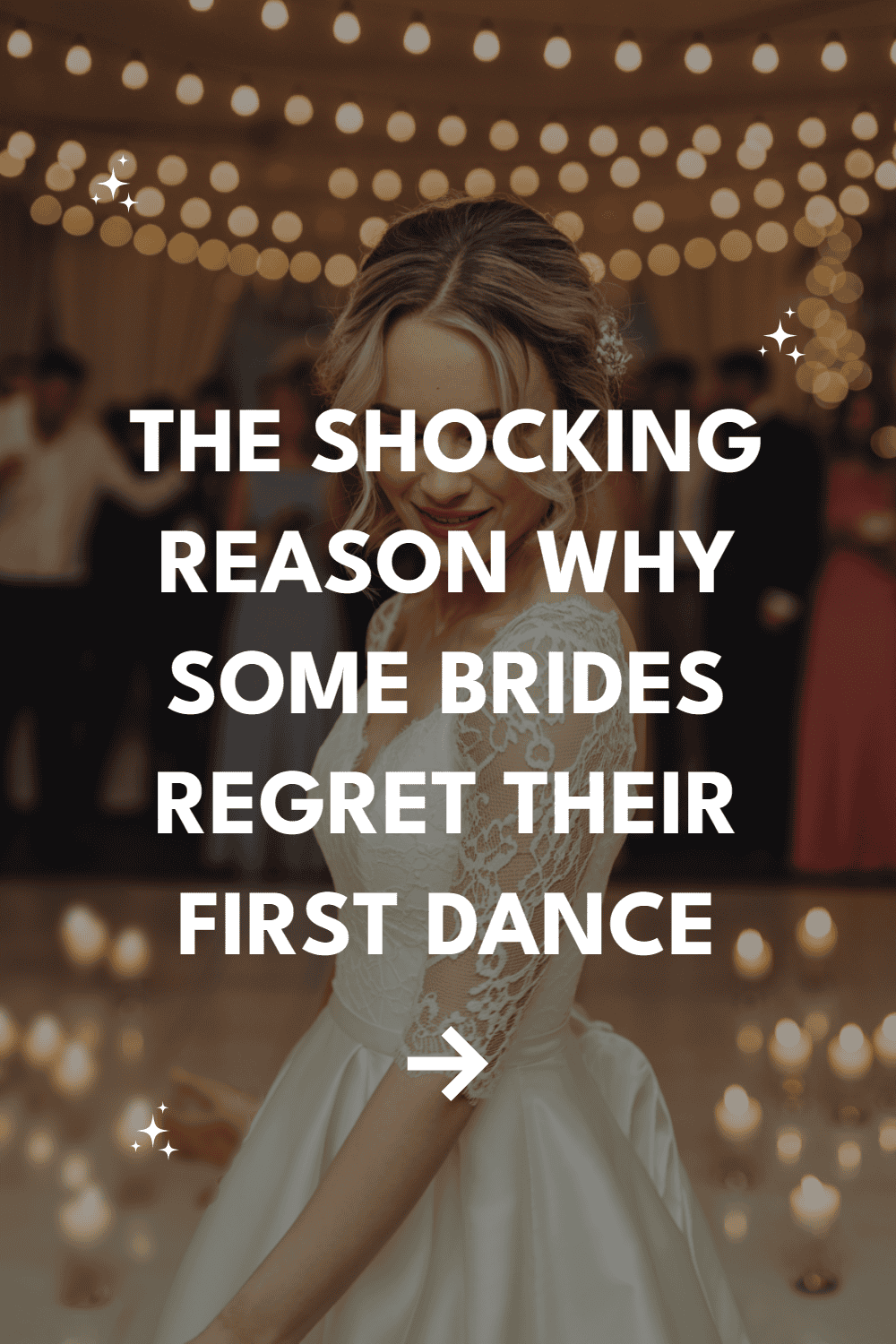Picture this: you’ve spent months planning the perfect wedding, every detail meticulously chosen. Then your first dance arrives, and instead of magical memories, you’re left with a cringe-worthy moment that makes you want to hide under your veil forever.
The brutal truth? Most brides regret their first dance not because of the song choice or their dancing skills, but because they completely misunderstood what this moment is actually about.
The Real Culprit Behind First Dance Disasters
It’s not about the performance. Yet somehow, somewhere along the wedding planning journey, couples convince themselves they need to put on a show that would make Dancing with the Stars jealous.
The pressure to impress guests transforms an intimate moment into a theatrical nightmare. Brides spend weeks learning choreography, stressing about every step, and forgetting that their guests aren’t Simon Cowell holding up scorecards.
When Pinterest Becomes Your Worst Enemy
Social media has turned the first dance into a competitive sport. Brides scroll through endless videos of couples executing flawless lifts, spins, and synchronized moves that took professional dancers years to master.
“We saw this amazing routine on TikTok and thought we could learn it in two weeks,” confessed Sarah, a bride from Chicago. “I spent our entire reception worried about messing up the choreography instead of enjoying the moment with my husband.”
The comparison trap runs deeper than just dance moves. Couples feel pressured to choose songs that sound impressive rather than meaningful, leading to awkward swaying to tracks that hold zero emotional significance.
The Perfectionism Trap
Wedding perfectionism reaches its peak during the first dance. Brides who’ve never cared about dancing suddenly become convinced they need to glide across the floor like Grace Kelly.
This obsession with flawless execution kills the joy completely. Instead of sharing a tender moment with their new spouse, brides are mentally counting beats and praying they don’t trip over their dress.
The irony hits hard when you realize guests barely remember the technical aspects of your dance. They remember the emotion, the connection, the authentic moments between you and your partner.
What Guests Actually Notice
Your guests aren’t dance critics. They’re your loved ones who want to see you happy, not stressed about hitting every mark in your choreographed routine.
The moments that stick are the genuine ones: when you laugh because someone missed a step, when you whisper something sweet in each other’s ears, when you’re clearly lost in your own little world despite being surrounded by people.
The Awkward Spotlight Effect
Many brides underestimate how exposed they’ll feel during the first dance. Even the most confident women can freeze when suddenly everyone’s attention focuses solely on them.
“I felt like I was under a microscope,” shared Jennifer, married last spring. “All I could think about was whether my dress looked okay from behind and if people could tell I was shaking.”
The spotlight effect becomes more intense when couples choose elaborate routines. Simple swaying allows for natural conversation and connection, while complex choreography demands your full attention on technique.
Reading the Room Wrong
Some couples plan their first dance without considering their audience or venue. A dramatic tango might work beautifully in a grand ballroom but feels completely out of place in a backyard reception.
The disconnect between your dance choice and your wedding vibe creates an uncomfortable atmosphere. Guests sense when something feels forced or inauthentic, even if they can’t pinpoint exactly why.
The Song Selection Minefield
Choosing your first dance song based on how it sounds rather than what it means creates instant regret. Countless brides have shared stories of dancing to songs they barely knew because they seemed “wedding appropriate.”
The emotional disconnect becomes painfully obvious during the actual dance. When you’re swaying to a beautiful melody that holds no personal significance, the moment feels hollow despite its supposed romance.
When Meaning Gets Lost
The most regrettable first dances happen when couples overthink the song choice. They analyze lyrics for hidden meanings, worry about tempo, and forget to choose something that actually represents their relationship.
“We picked ‘At Last’ because it’s a classic wedding song,” admitted Rebecca. “But we’d never listened to it together, never sang along in the car. It felt like we were acting out someone else’s love story.”
Personal connection trumps popular opinion every single time. A song that makes you both smile will create better memories than the most beautiful ballad that means nothing to you.
The Tempo Trap
Many couples choose songs without considering how they’ll actually dance to them. Slow songs can feel endless when you’re uncomfortable, while upbeat tracks might not match the romantic atmosphere you’re trying to create.
The key lies in picking something that feels natural to move to together. If you naturally sway when the song comes on at home, it’s probably a winner for your first dance.
The Choreography Catastrophe
Professional choreography works for professionals. When regular couples attempt complex routines, the results often feel stiff and unnatural rather than romantic and flowing.
The rehearsal process becomes a source of stress instead of bonding time. Couples fight about who’s missing steps, worry about forgetting the routine, and lose sight of why they wanted to dance together in the first place.
When Simple Wins
The most memorable first dances often involve the least choreography. Couples who focus on connection rather than perfection create moments that feel authentic and touching.
Natural movement allows for spontaneity and genuine emotion. You can whisper to each other, share private jokes, and actually enjoy the experience instead of performing through it.
Consider this comparison of bride experiences:
| Choreographed Routine | Simple Swaying |
|---|---|
| Weeks of stressful practice | Natural, no pressure |
| Focus on technical execution | Focus on each other |
| Fear of making mistakes | Room for spontaneous moments |
| Performance for guests | Intimate connection |
| Rigid timeline | Flexible and relaxed |
The Practice Pressure
Couples who choose elaborate routines often underestimate the time and stress involved in learning them. Wedding planning already consumes enormous energy, and adding dance lessons can push stress levels over the edge.
The practice sessions become another item on an already overwhelming to-do list. Instead of enjoying time together, couples find themselves frustrated with missed steps and conflicting schedules.
The Venue Reality Check
Your beautiful choreography might not translate to your actual wedding space. Many couples practice in dance studios with perfect floors and unlimited space, then face the reality of a crowded reception hall with challenging surfaces.
Environmental factors can sabotage even the best-planned routines. Outdoor venues might have uneven ground, historic buildings could feature slippery floors, and smaller spaces might not accommodate sweeping movements.
The Dress Factor
Wedding dresses aren’t designed for complex dance moves. Trains, long veils, and fitted silhouettes can turn simple spins into dangerous maneuvers.
Many brides realize too late that their dream dress and dream dance don’t work together. The resulting compromise satisfies neither vision and creates unnecessary stress on the wedding day.
The weight and structure of wedding attire affects movement in ways couples rarely consider during planning. What feels graceful in street clothes can become clunky and awkward in full wedding regalia.
Technical Difficulties
Modern weddings involve complex lighting and sound systems that can impact your first dance experience. Spotlights might be too bright, music might start at the wrong volume, or technical glitches might interrupt your carefully timed routine.
Flexible plans handle technical issues better than rigid choreography. When your dance depends on precise timing and specific music cues, any technical problem becomes a major disaster.
The Emotional Disconnect
The biggest regret isn’t about missed steps or forgotten moves—it’s about missing the emotional significance of the moment.
Brides who focus too heavily on performance often realize later that they barely connected with their partner during their first dance as a married couple.
This realization hits hardest when looking back at photos and videos. Instead of seeing joy and connection, they see concentration and stress written across their faces.
Lost in Translation
The first dance represents your transition from individuals to a married couple. When the focus shifts to entertaining guests rather than celebrating your union, the symbolic meaning gets lost completely.
Authentic emotion creates the most beautiful wedding photos. Professional photographers consistently report that candid moments during simple dances produce more stunning images than perfectly executed routines.
The vulnerability of sharing a quiet moment together, surrounded by your loved ones, creates powerful memories that elaborate performances simply can’t match.
The Memory Gap
Brides often report feeling like their first dance passed in a blur of anxiety and concentration. The very moment they wanted to savor becomes a hazy memory of stress and relief when it ended.
When you’re focused on performance, you miss the experience entirely. The irony cuts deep when you realize you sacrificed the memory for the sake of impressing people who would have been equally happy watching you sway together.
The Guest Perspective Truth
Your guests want to witness your happiness, not judge your dancing ability. The emotional disconnect becomes obvious when couples prioritize technical skill over genuine connection.
Wedding guests are invested in your love story, not your dance skills. They’re watching for moments of tenderness, joy, and connection that remind them why they’re celebrating your marriage.
What Really Matters
The first dances that guests remember most fondly are those where the couple’s love for each other shines through clearly. Technical perfection pales in comparison to authentic emotion.
Guests can sense when couples are genuinely enjoying themselves versus when they’re performing. The energy in the room shifts dramatically depending on whether the couple is connecting with each other or focusing on their audience.
Simple gestures like whispering in each other’s ears, sharing quiet laughter, or getting lost in the moment create far more impact than perfectly executed dance moves.
Making Peace with Your Choice
If you’re already committed to a choreographed routine, focus on making it feel natural and personal. The goal should be enhancing your connection, not showcasing your skills.
Permission to change your mind exists right up until the music starts. Many couples discover that their elaborate plans feel wrong on the actual wedding day, and that’s perfectly okay.
Flexibility serves you better than rigid adherence to plans that no longer feel right. Your wedding day intuition often knows better than months of advance planning.
The Recovery Plan
Brides who regret their first dance can find peace by focusing on what the moment represented rather than how it looked. The symbolic significance of your first dance as a married couple remains meaningful regardless of technical execution.
Future anniversary dances offer opportunities to create the intimate moments you might have missed. Many couples establish traditions of dancing together at home, reclaiming the romantic connection they lost in their wedding performance anxiety.
The real magic happens in all the dances that follow your first one—the private moments in your kitchen, the anniversary celebrations, the spontaneous swaying when your song comes on the radio.
Finding Your Authentic Moment
The most beautiful first dances happen when couples forget about their guests and focus entirely on each other. This shift in attention transforms performance anxiety into intimate connection.
Your first dance should feel like an extension of your relationship, not a departure from it. If you never dance together at home, an elaborate wedding routine will feel foreign and uncomfortable.
Consider how you naturally move together when you’re alone. Do you sway in the kitchen while cooking? Dance silly in the living room? These natural movements often translate better to wedding settings than formal choreography.
The goal is creating a moment that feels authentically yours, regardless of what anyone else thinks or expects. Your wedding day belongs to you and your partner—not to the performance expectations of others.


